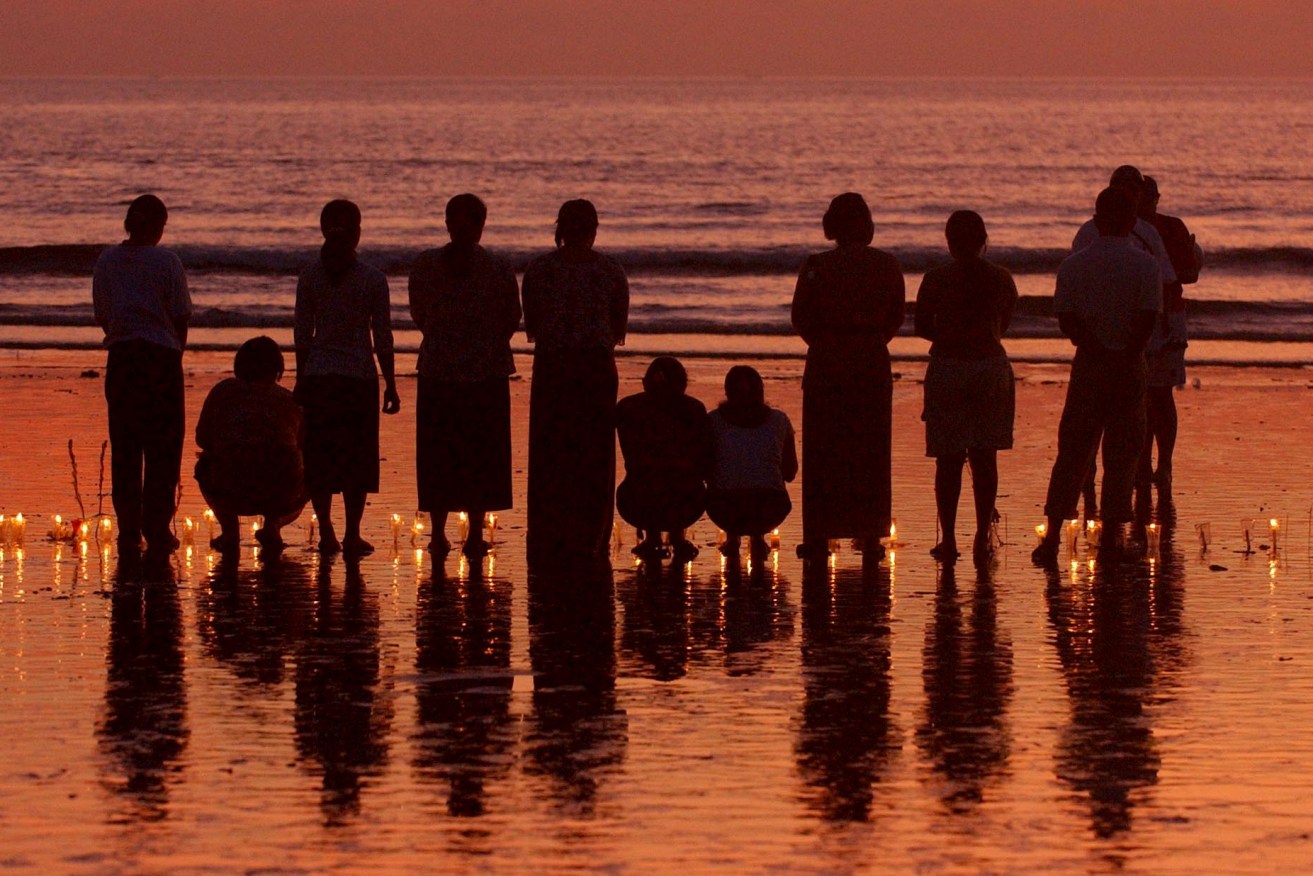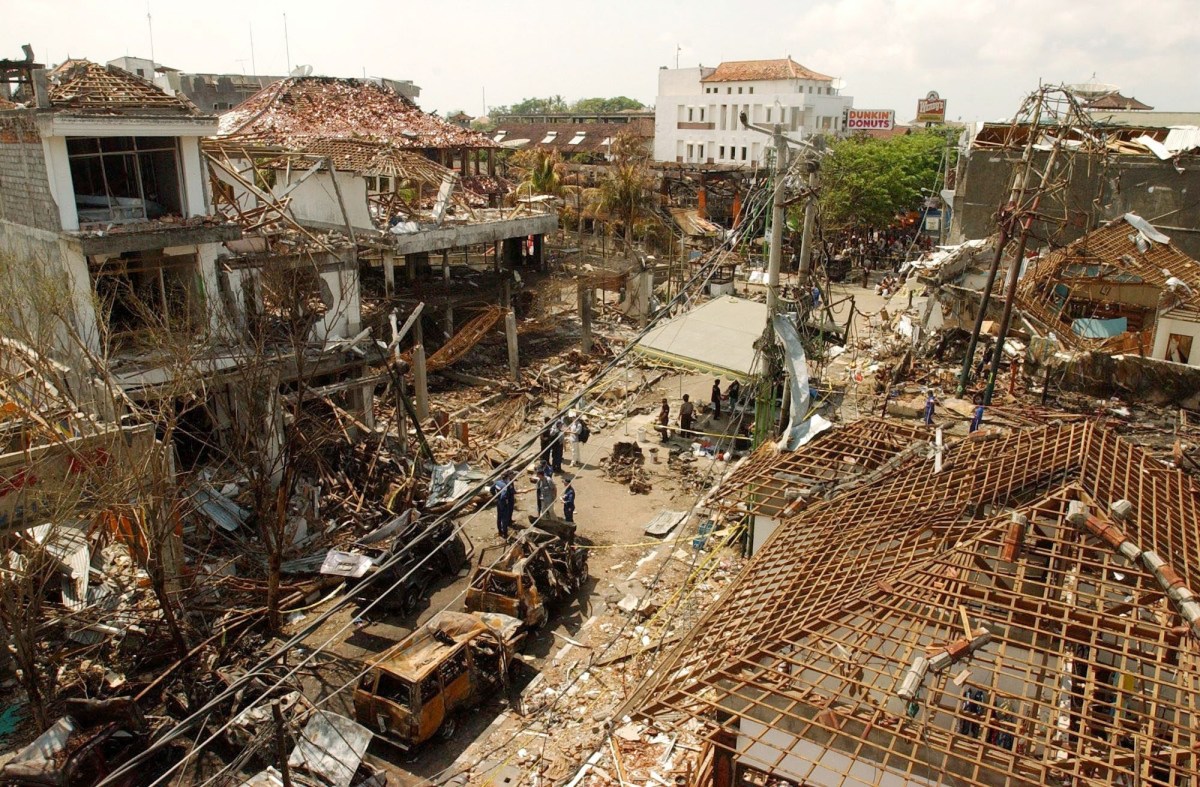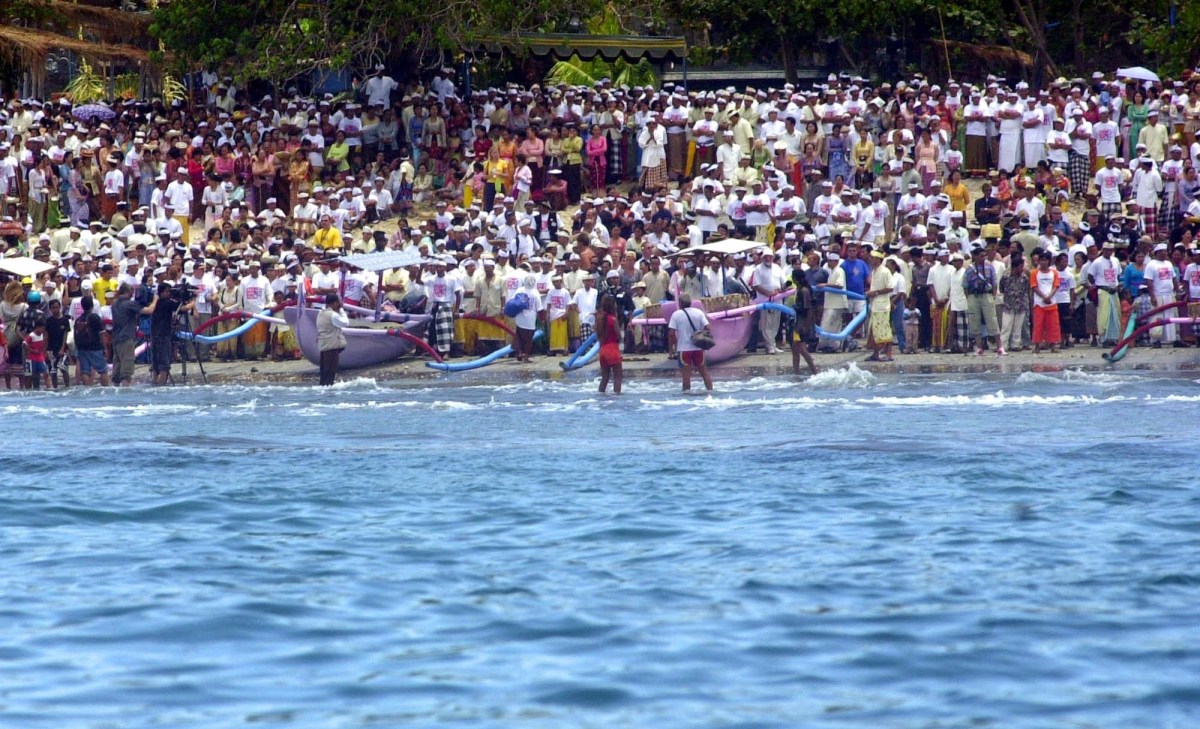Remembering the Bali bombings
On the sixteenth anniversary of the first Bali bombings, veteran Adelaide journalist Alan Atkinson remembers the family holiday that turned to horror and the factors that allowed him to keep going in those raw, terrible days.

Balinese women light candles at sunset during an informal ceremony on Kuta Beach on the one-year anniversary of the first Bali bombings. Photo: Mick Tsikas/AAP
Mostly I can’t recall what I was doing 16 years ago – except that I can remember all too clearly the three weeks I spent in Bali with my wife Margie and children Sarah and Nick – aged 14 and 12 at the time – when the bombings happened. More than 200 people were killed, including 88 Australians.
It feels like yesterday.
Many of us forget very quickly, sometimes because of the passage of time and sometimes because the shock and the trauma may be too awful to contemplate. Unless we are directly affected, most of us like to move on quickly from too much horror – real horror, that is, as opposed to TV or movies when you can just press mute or turn it off.
One way of dealing with a traumatic event is to talk about it or to write it down.
That’s why I wrote Three Weeks in Bali. I was asked to do so by the ABC. By the sheer accident of being on holiday in Bali at the time, I was one of the first western journalists on the scene. I reported back to Australia alone for the first 12 hours, until a team of ABC colleagues arrived.
Although I had been writing for newspapers, TV and radio for years, I had never written like this before, nor had I written anything so quickly. It took just one week. I was only able to write it because the story and the images were imprinted so clearly on my memory – by the adrenalin rush perhaps, when everything becomes vivid, because you are on a heightened state of alert.
I remember thinking after the book had gone to press that I couldn’t have written it a few months later – the details would have a bit more blurred, the pictures less intense, the memories a little hazier.
It’s short, just about 25,000 words, and is now an e-book available from Harper Collins, which now runs ABC Books. It’s really a daily diary of just 15 days.
The first section describes what many families experience when they holiday in Bali: beaches, snorkelling and surfing and massages on the sand, pools, great food, green rice paddies and running streams, volcanoes, temples big and small, an intriguing mix of Hindu, Islamic and Animist religions, gamelan music, little homestay cottages surrounded by greenery and water, animals, birds, artworks, carvings, and of course, apart from pushy street vendors, some of the friendliest people on earth.
A few days before the bombings we went on a dawn trip by outrigger canoe to go snorkelling and to see dolphins off the north coast at Lovina Beach.
Possibly unwisely, I had booked a cut-price deal and our skipper met us before dawn and showed us to this flimsy looking outrigger canoe drawn up on the beach.
“Where are the life-jackets?” I asked. The skipper, who didn’t speak much English, smiles, laughed: “You swim!” What was it the hotel told us about cheap trips? Only the hotel can guarantee safety.
Along the beach, I could see a number of hotel boats being prepared. Other hotel residents were donning life-jackets. Soon we would be speeding out to sea, as the sun came up over the mountains. The sea was very calm, the outrigger looked stable enough, the outer pontoons on both sides roped on strongly. What could possibly go wrong?
The tiny two-stroke engine spluttered into life and we headed out towards the horizon well ahead of the hotel boats. Then, the engine stopped and the outrigger began to gently circle as the skipper struggled with some ropes. “Sorry, sorry, one moment,” he said. He was holding the steering mechanism and trying to rope it back into position. To our left the hotel boats were speeding ahead, their life-jacketed passengers leaning forward in eager anticipation of a close-up encounter with dolphins.
We finally started again, but then disaster struck. One pontoon came loose and started flailing from side to side. “Oh dear, big problem,” said the skipper, leaping past me to the bow. “Sorry, sorry. I fix it.”
He jumped into the water and we watched his bulging muscles as he held the arching frame with his arms, the pontoon with his legs, and forced them back together, before roping them up again. This cost us a good few minutes of dolphin-watching time, but we were so impressed with his efforts that when he got back on board we gave him a round of applause. We were also aware that he needed encouragement – he was holding four lives in his hands.
We’d long since given up hope of seeing the legendary Lovina dolphins. “Maybe we can see them in the Port River,” Sarah suggested helpfully. The hotel boats were almost out of sight. Then Nick gave a shout. The hotel boats were heading back our way. ‘There, there,” shouted the skipper and six dolphins came looping out of the water just in front of us. “Terrific,” we said. “Good,” said the skipper, wiping his brow with relief.
That was on Friday. On Saturday we were driven back over the mountains to Legian. I’ve noted in the book that “it feels almost claustrophobic after spending time in Ubud and Lovina to be back on the tourist strip”.
But we were soon in the festive mood again and on Saturday evening we strolled up Legian Street. It was crowded as usual, full of colour and energy and young people heading out for a good time. We wandered past Poppy’s Restaurant but decided not to eat there that night. We decided to eat further on then walk back along the beach as the sun set.
And that was the end of the holiday.
From the early hours of next morning, I was reporting back to the ABC in Australia everything I saw in the short time after explosions destroyed two clubs, Paddy’s Bar and the Sari Club, packed with young people from all over the world.
In the early hours of Sunday morning, I was alerted from the ABC in Sydney that there had been some kind of blast at a hotel.
Running towards the devastated area in Kuta, I asked a man on a street corner: “What was it?”.
“An explosion of some sort,” he said. “It shook our hotel. It was inland, not on the beach.” He said he went to his window and saw a huge fireball going up into the sky. He thought it could have been a gas explosion.
As I approached Legian Street I saw people up ahead in the dim light. Most shops were closed, given the hour. As I got closer I was astonished to see window after window had been smashed. There was glass all over the road and shopkeepers were wandering with brushes trying to clean up. This couldn’t be just an explosion, I thought. Someone has gone a rampage here smashing every window in sight. The shopkeepers scarcely glanced at me. They look shocked. There was a two-storey shopping complex on my right and I saw with astonishment that all the upper windows were smashed too. What? How could whoever had done this get up there? It didn’t make sense. A police car came screaming round the corner followed by ambulances with sirens wailing. Then came a large truck carrying police and soldiers. I was still bewildered about the glass strewn everywhere.
But it was slowly dawning on me that if it was really the explosion that caused all this, then it must have been huge.

The site of the first Bali bombings, showing the extent of the damage. Photo: AAP/Dean Lewins
For the next day, it was me and a phone, reporting from the devastation around the bomb sites, the morgue, the hospital and then at the airport where tourists were now streaming to catch planes home.
My wife Margie was unwilling to rush home – we all felt very sorry for the Balinese – and they decided to stay around the hotel for a day or so while I was busy reporting.
It was the most hectic, shocking, confronting, heart-wrenching two weeks of my career as a journalist.
But, as a journalist, in my view, it was my job to keep a cool head and, first and foremost, report as faithfully as I could about what I was seeing and hearing.
It wasn’t just a matter of describing for viewers and listeners back in Australia the dreadful scenes at the bomb sites or the hospitals, we had to stay on top of fast-moving developments such as media conferences by the Australian federal police, grief-stricken, angry and frustrated relatives demanding answers about their loved ones, visits by Australian politicians such as the Prime Minister and Foreign Minister, as well as keeping tabs on the search for the perpetrators and all the speculation being ramped up by overseas commentators that it must have been, like 9/11, the work of Al Qaeda.
Whatever you think of politicians, sometimes they have an incredibly difficult job to do. John Howard, always pretty good off the cuff, spoke from the heart in thanking the emergency workers.
But imagine being asked this by an Australian dad at a crowded media conference: “My son is missing He’s six foot four. He’s got a distinctive watch. He’s got capped teeth. He’s had an arm reconstruction. Is it going to take six weeks to find him?”
The PM replied: “I feel for you. I wish I could name the day.” He said he understood the anguish all the relatives felt in having to wait so long, but the forensic teams had a very difficult job to do and identification must be right.
*
Many people have asked me what it was like to be in the middle of it – and how I kept a cool head.
I guess I was lucky. Lucky to have already had many years of experience reporting, lucky that I did not lose anyone myself and that Margie and Sarah and Nick could go home safely while I stayed on, and especially lucky – after the first 24 hours – to be part of a team of ABC journalists like Tim Palmer and Peter Cave, who had worked a great deal in war zones before. I think if any one of those three things had been different – the safety of my family, my own experience, and working as a team – then I would not have been able to keep a clear head and report as I did. I know other journalists who became so involved in the search and recovery of victims and so involved with the grieving families that they not only found it hard to report objectively but also suffered themselves later, some dreadfully badly.
But dealing with trauma manifests in different, unexpected ways. Sometimes small ways. In the book I write:
I’ve noticed some changes in my own behaviour in the past week. I’ve become quite obsessive about tidiness. Back in Adelaide, I’m normally pretty organised at work, due to the pressure of deadlines, but less so at home. Now I find I’m tidying my hotel room. I don’t like food left on the room service dinner plate after I’ve finished. I go and wash it up. I can’t bear for my clothes to be in a mess. I tidy up my notebooks and pens. I think Margie would be very happy if she saw this. I realise my new-found tidiness is a result of all the chaos I’ve seen.
It was a dreadful, memorable time. The Balinese people were shocked and saddened and kept apologising to us, as if it was their fault, and kept asking if we would ever come back. Fortunately, after a period, people began to take holidays in Bali again.
I vividly remember the Tuesday, three days after the bombing with Kuta still a hive of activity, with troops and police guarding the bomb site from tourists, sightseers and media from all over the world. The Australian Foreign Minister was due to fly in to inspect the scene and meet the Indonesian Government.
On the other side of the barrier keeping the assembled media crews away from the site is a line of Indonesian soldiers. Some look no more than 18 years old. They don’t smile at all. They carry large automatic rifles and their job is to keep us in order….reporters, camera crews and photographers are becoming agitated. They’ve got to get pictures of the Foreign Minister visiting the bomb site.
Suddenly everything goes quiet. A group of young women, all dressed in black come towards the barrier. They’re the young staff from a surf shop just across the road from the Sari Club. One of their colleagues was killed. They’re all carrying lilies. They stand in a line across the road, facing the soldiers and the media and then one of them moves to the front. With her eyes closed, she begins to sing. Ave Maria. Cameras are quietly turned on. I hold out my phone near the singing woman to record it. I can see some of the reporters nearby have tears in their eyes. Then the girls one by one, in silence, lay their lilies down on the street, turn and walk slowly back to their shop. It is a very moving moment. It brings into focus once again the immeasurable grief being suffered by the families and friends of victims from all over the world.
After a week or so my job was done and the ABC team scaled down, leaving two correspondents to carry on.
Before I left, I attended two rituals performed by the Balinese. The first was a cleansing ritual, explained to me by American Debe Campbell. She’d lived and worked in Bali for years and was then working at the media centre at the Hard Rock Hotel as an interpreter.

Thousands of Balinese gather on the beach for the mass purification ceremony in Kuta on November 15, 2002. Photo: AP/Achmad Ibrahim
She explained there would be three Hindu rituals. In the first two, the Balinese would pray for forgiveness and ask for the chance of a better life. Then there would be a special ritual to ‘purify the area’ and ask for blessings for the population. She explained the Hindu principle of balance – between humans and the almighty, between humans and humans and between humans and nature. She said the Balinese believed that the explosions caused the most severe disturbance to this balance – and prayer and offerings were required to restore it.
Later that afternoon I join the crowd gathered near the bombed out Sari Club. Schoolchildren are carrying flowers as are many tourists, some wearing bandages. The site now has a giant pile of wreaths beside it. In front of it a group of women priests (in this tradition the wives of male priests are priests themselves) present offerings. The male priests, with white headbands, burn incense. Over a loudspeaker a senior priest begins intoning. I do not understand the words but the voice rises and falls as if the speaker is crying. The sound is quite haunting. Priests circle the remains of both Paddy’s Bar and the Sari Club sprinkling holy water.
The second very moving ritual was on the beach before sunset the day before I flew out. Hundreds of Balinese and Westerners gathered beside the sea. We were all given flowers. Gamelan music was played. The crowd formed a semi-circle facing the sea. There were prayers from the priests. Then everyone moved to the sea’s edge.
Three Balinese women carrying bowls full of red rose petals begin to scatter them on to the waves. Balinese and Australians, many in tears, follow suit, throwing their flowers into the water. Soon there’s a carpet of flowers glistening in the sunshine.
So as we remember today the families of the 88 Australians who died, I hope we can also remember that beautiful image.
Journalist Alan Atkinson worked for the ABC for more than 20 years and was day editor of the Adelaide newsroom.
If this story has raised concerns for you, call Lifeline: 13 11 14.




